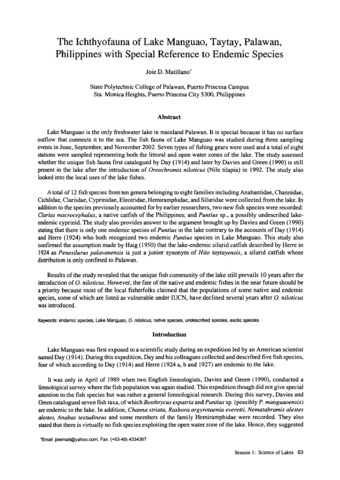Fish biodiversity and incidence of invasive fish species in an aquaculture and non-aquaculture site in Laguna de Bay, Philippines
- Global styles
- MLA
- Vancouver
- Elsevier - Harvard
- APA
- Help

View/
Date
2014Author
Page views
7,458ASFA keyword
AGROVOC keyword
Geographic names
Metadata
Show full item record
Share
Abstract
Laguna de Bay is the Philippines' largest inland water with 900 km2 surface area. The lake has been assessed as hypereutrophic (Rohani and Roblo, 1984) to dystrophic (Barril and Tumlos, 2002). To make use of the lake's natural productivity a pilot aquaculture project started in 1971 (del Mendo and Gedney, 1979). The aquaculture industry in the lake rapidly developed, mainly using species not native to the lake. Since then, the lake has become a major source of fish in Metro Manila and the adjacent provinces.
An assessment of the impact of aquaculture in the lake showed increased total finfish biomass in the lake; ecotrophic efficiency of phytoplankton increased; and the calculated total net primary production decreased by a factor of two compared to the pre-aquaculture period (de los Reyes, 1993). The dominant species cultured in Laguna de Bay are introduced species. After more than 40 years the lake is now populated with non-native species including species that are considered invasive and nuisance. Many of these species were deliberately introduced for aquaculture and there are those that were considered accidental introductions like ornamental fish cultured in ponds within the lake's watershed.
To assess the impact of aquaculture in localized areas in the lake, a study was conducted to monitor diversity in the fisheries resources of the lake at two adjacent, but distinctly different sites: the West Cove (WC), an open fishery area, with no aquaculture and the East Cove (EC) which is an aquaculture site with cages for Nile tilapia, bighead carp, giant freshwater prawn.
Suggested Citation
Cuvin-Aralar, M. L. A. (2014). Fish biodiversity and incidence of invasive fish species in an aquaculture and non-aquaculture site in Laguna de Bay, Philippines. In C. Biscarini, A. Pierleoni, & L. Naselli-Flores (Eds.), Lakes: The Mirrors of the Earth. Balancing Ecosystem and Human Wellbeing. Proceedings of the 15th World Lake Conference (Vol. 2, pp. 53-57). Italy: Science4Press.
Type
Conference paperCollections
- Conference Proceedings [299]
Related items
Showing items related by title, author, creator and subject.
-
Status of threatened species and stock enhancement activities in the Philippine fisheries
Lopez, Nelson A. (Aquaculture Department, Southeast Asian Fisheries Development Center, 2006)The paper provides the lists of fisheries related species perceived to be extinct, rare, threatened and endangered as covered under the CITES, IUCN and the Bureau of Fisheries and Aquatic Resources (BFAR)-Fisheries ... -
Proceedings of the Regional Technical Consultation on Stock Enhancement for Threatened Species of International Concern, Iloilo City, Philippines, 13-15 July 2005
Primavera, Jurgenne; Quinitio, Emilia; Romana-Eguia, Maria Rowena R. (Aquaculture Department, Southeast Asian Fisheries Development Center, 2006)This 150-page book documents the proceedings of an experts' consultation held at AQD in July 2005. It contains nine review papers and seven country papers. -
The ichthyofauna of Lake Manguao, Taytay, Palawan, Philippines with special reference to endemic species
Matillano, Joie D. (Southeast Asian Regional Center for Graduate Study and Research in Agriculture (SEARCA), 2005)Lake Manguao is the only freshwater lake in mainland Palawan. It is special because it has no surface outflow that connects it to the sea. The fish fauna of Lake Manguao was studied during three sampling events in June, ...






